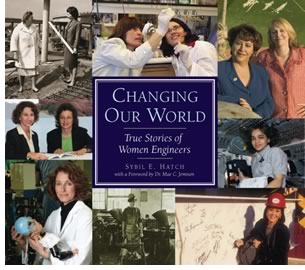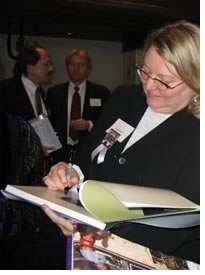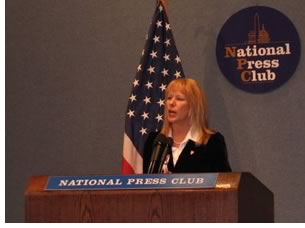

3/2006
New book aims to inspire more females to consider engineering

by Tracy Ostroff
 Women engineers traded signatures and congratulations February 21 on
the publication of the new book Changing Our
World: True Stories of Women Engineers, by Sybil Hatch, published by the American Society of Civil
Engineers, 2006. Through its engaging 256 pages, Changing
Our World aims
to inspire a new generation of females to consider careers in engineering.
The book, launched at a reception at the National Press Club in Washington,
D.C., during Engineers Week, is the first product of the Extraordinary
Women Engineers Project Coalition (EWEP).
Women engineers traded signatures and congratulations February 21 on
the publication of the new book Changing Our
World: True Stories of Women Engineers, by Sybil Hatch, published by the American Society of Civil
Engineers, 2006. Through its engaging 256 pages, Changing
Our World aims
to inspire a new generation of females to consider careers in engineering.
The book, launched at a reception at the National Press Club in Washington,
D.C., during Engineers Week, is the first product of the Extraordinary
Women Engineers Project Coalition (EWEP).
Organizers say the longstanding under-representation of women in the engineering professions served as the catalyst for the formation of the EWEP—which represents nearly 60 engineering organizations, including government agencies, corporations, professional societies, and universities—and which is dedicated to encouraging more young women to pursue careers in the engineering fields. Changing Our World notes: “Although the number is hard to pin down, estimates indicate that there are over a million engineers practicing in the U.S. today. Around 100,000 are women. And each one has a story to tell.”
 Changing Our World conveys 238 of these stories via punchy quick-read
profiles of women in all fields of engineering. The biographies include
the young and the older; the lesser experienced and the veterans of the
industry; and engaging full-color photos to illustrate the text. The
book’s 14 chapters are divided into practice areas to show young
people how engineering touches every aspect our lives, the author says.
The subjects start with bioengineering and continue onto other topics:
agriculture and goods; shelter and community (with a profile of Julia
Morgan, architect and civil engineer); environment; transportation; entertainment;
telecommunications; electricity; flight; space; and defense. The penultimate
chapter looks at the trailblazers, pathfinders, and scouts of women in
engineering. “Engineering is a passionate profession full of brave
and determined women who loved engineering so much that they fought for
the right to practice it.” The last chapter focuses on “next
steps.”
Changing Our World conveys 238 of these stories via punchy quick-read
profiles of women in all fields of engineering. The biographies include
the young and the older; the lesser experienced and the veterans of the
industry; and engaging full-color photos to illustrate the text. The
book’s 14 chapters are divided into practice areas to show young
people how engineering touches every aspect our lives, the author says.
The subjects start with bioengineering and continue onto other topics:
agriculture and goods; shelter and community (with a profile of Julia
Morgan, architect and civil engineer); environment; transportation; entertainment;
telecommunications; electricity; flight; space; and defense. The penultimate
chapter looks at the trailblazers, pathfinders, and scouts of women in
engineering. “Engineering is a passionate profession full of brave
and determined women who loved engineering so much that they fought for
the right to practice it.” The last chapter focuses on “next
steps.”
Hatch calls the publication a “once-in-a lifetime opportunity.” Hatch, who received an undergraduate and graduate degrees in civil engineering from Virginia Tech, says her own experience had taught her that engineering education and practice is a valuable tool applicable to many career choices for women.
Sound familiar?
These stories, of course, are not unlike those faced by women in architecture.
Like a recent AIA
demographic study that showed that women are more
likely to consider architecture as a career later than men, the engineering
societies find the same trends in their profession.
The Engineers Week 2006 program agenda includes training sessions for
engineers and engineering students on how best to work with teachers
and others in middle school environments.
“The importance of reaching young people in seventh and eighth grades shouldn’t be underestimated," says Patricia Welesko Garland, chair of Engineers Week 2006 activities, and a chemical engineer who is currently Combined Heat and Power Program Manager at Oak Ridge National Laboratory based in Washington, D.C. "Students introduced to the potential and promise of engineering at this age have a much greater inclination to pursue it as a career in later years."
EWEP is developing messaging techniques and a long-range plan with educators and engineers to inspire young women to enter the engineering field and to nurture role models for those in the field.
 Hatch says the organization is hoping to use these stories as a resource
for education outreach programs. “An even larger problem is the
lack of recognition for women engineers’ remarkable accomplishments.
If the work of engineers is subtle, the work of women engineers has remained
largely invisible,” Hatch writes in the book’s acknowledgements.
Organizers note, “The program components will provide both inspiring
personal stories and a girl-friendly collection of hands-on activities
that inspire young women to explore engineering as a career choice. In
addition, the program will provide resources to those individuals with
the capacity to influence and advise girls at the stage when they make
decisions and careers.” The group reports that other initiatives
include a television documentary, corresponding resources and training,
and national outreach programs.
Hatch says the organization is hoping to use these stories as a resource
for education outreach programs. “An even larger problem is the
lack of recognition for women engineers’ remarkable accomplishments.
If the work of engineers is subtle, the work of women engineers has remained
largely invisible,” Hatch writes in the book’s acknowledgements.
Organizers note, “The program components will provide both inspiring
personal stories and a girl-friendly collection of hands-on activities
that inspire young women to explore engineering as a career choice. In
addition, the program will provide resources to those individuals with
the capacity to influence and advise girls at the stage when they make
decisions and careers.” The group reports that other initiatives
include a television documentary, corresponding resources and training,
and national outreach programs.
“Through our collective efforts, the coalition has made outstanding progress toward our goal of encouraging more academically prepared young women to choose engineering careers,” says EWEP Steering Committee Chair Patricia D. Galloway, PhD, PE. “We have identified the top five career motivators for girls and learned who most influences their career choices, as well as documented inspirational stories of hundreds of diverse women engineers who can serve as role models.” Galloway is also the past president of the American Society of Civil Engineers, the first woman to hold the position in the Society’s 152-year history.
Copyright 2006 The American Institute of Architects.
All rights reserved. Home Page ![]()
![]()
To learn
more about the Extraordinary Women Engineers Project Coalition and to
order Changing Our World, visit the
ASCE Web site. ![]()
![]()